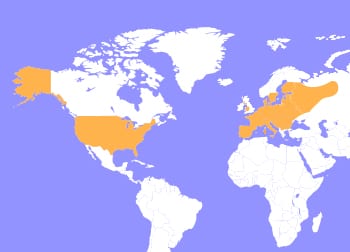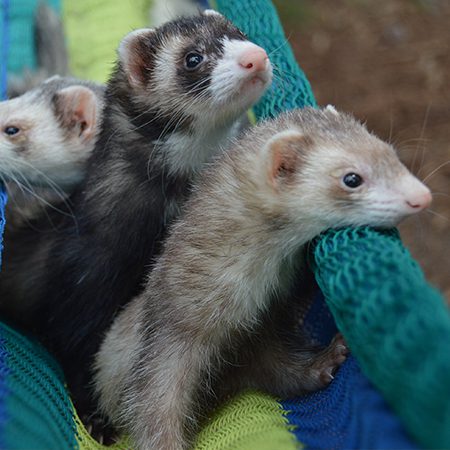Ferret
Mustela putorius furo
Ferrets are the domesticated form of the European Polecat, a mammal that belongs to the same genus at the weasel, Mustela. Ferrets typically have fur in brown, black, white, or mixed. On average they are 20 in long, including a 5 in tail; they weigh between 1.5 - 4 lbs. They can live anywhere from 7 to 10 years.
Being so closely related to polecats, it's been observed that ferrets easily hybridize with them. This has resulted in feral colonies of polecat-ferret hybrids, they’ve been seen as pests in New Zealand causing damage to native fauna. The history of the ferrets domestication is still uncertain, they are still used for hunting rabbits in some parts of the world, and kept as pets. Ferrets have a known feature of their scent glands, located near their rear end. Secretions from this are used in scent marking; ferrets can recognize individuals from these anal gland secretions, as well as detect mating partners.
The name “ferret” is derived from the Latin furittus, meaning “little thief”, possibly referencing the common ferret behavior of hiding away small items. Ferrets have a typical mustelid body-shape, being long and slender. Ferrets will usually spend 14-18 hours a day sleeping, and is most active around dawn and dusk, meaning they are crepuscular. They can be territorial, like to burrow, and prefer to sleep in an enclosed area. Most ferrets will live happily in social groups; a group of ferrets is commonly referred to as a “business”.
Say Hello To Cub Creek's Ferrets: Jafar, Ursula, Spirit, Bemo, and Lucy
Jafar and Ursula came together in May of 2019. They have calmer personalities; some of you might even know Jafar from his visits to camp fairs! They are both nearly all black in coloring, but Jafar is a bit bigger. Spirit, Lucy, and Bemo are recent additions to camp, joining us at the end of 2019. They all share a playful and adventurous personality. Spirit and Bemo are boys; Spirit can be distinguished by the stripe down the back of his neck. Lucy is a girl with a stripe on her chest.

Ferrets were originally domesticated from ancestor Pole Cats in Europe. They've since been transported through North America.
HABITAT -Ferrets live in a home environment with a human, feral populations will live in forest environments.
DIET -Wild ferrets eat small prey, meat, organs, bones and all. With ferrets eating specialized ferret food.
FUN FACT -When excited, ferrets make vocalizations called “dooks”.
SOCIAL BEHAVIOR -Most ferrets will live happily in social groups; a group of ferrets is commonly referred to as a “business”.
ACTIVITY -Ferrets are most active around dawn and dusk, meaning they are crepuscular.
PREDATORS -Common predators of wild ferrets include coyotes, badgers, owls, hawks, eagles, and bobcats.
SIZE -They have an average length of 20 in, weighing between 1.5 - 4 lbs.
RELATIVES -Ferrets belong to the Mustela genus, they are related to weasels.
CONSERVATION -The domesticated ferrets is considered Not Evaluated on the IUCN Red List.
Cub Creek Animal Care Information
Housing - Our ferrets live together in a small “business”, they all inhabit a specialized enclosure giving them plenty of room to play and explore. You’ll find natural tree branches, ramps, and toys included in the enclosure for them to play with. There enclosure is bedded with shavings to help make clean up easy, and provide a space for them to have access to clean water.
Diet - We feed our ferrets a specialized premium ferret food, to ensure they are getting all the nutrition they need. Being carnivorous, requires a meat-based protein diet, this food contains high amounts of protein, vitamins, and minerals.
Enrichment - Our ferrets are given plenty of time, love and affection by humans, they are very accustomed to human interaction. Allowing them all this human interaction, means they are highly sociable, especially with campers during the summer time. There enclosure is covered in toys for them to play with, things plastic ball pits, ramps, and hides they love to explore. Campers will make them special enrichment toys during the summertime as well, these are usually made from cardboard, that ferrets love to chew and cause mischief with.

